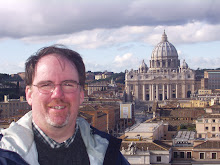 Have you ever thought about how you would go to confession if you were deaf? Could you be a lector who uses a wheelchair if there is a step up to the ambo? An extraordinary minister of Holy Communion with Parkinsons? Or a choir member who can't navigate the steps to the choir loft?
Have you ever thought about how you would go to confession if you were deaf? Could you be a lector who uses a wheelchair if there is a step up to the ambo? An extraordinary minister of Holy Communion with Parkinsons? Or a choir member who can't navigate the steps to the choir loft?What if you are just a plain pew-sitting Catholic person who is losing her hearing and can't really make out the homily? Or your sight isn't what it once was and you can't read the small type in the hymnal? (I imagine that some reading this blog face these challenges every day!)
Statistics show the 20% of Catholics have a disability. Some are very noticeable to those around them. Some are known only to the individual and to God. Since our worship involves the whole body and all of the senses, this is a significant issue that rarely is addressed. The US Bishops issued a Pastoral Statement on People with Disabilities in 1978. In it, they said:
It is essential that all forms of the liturgy be completely accessible to people with disabilities, since these forms are the essence of the spiritual tie that binds the Christian community together. To exclude members of the parish from these celebrations of the life of the Church, even by passive omission, is to deny the reality of that community. (paragraph 23)
The Bishops realized that this isn't easy. They added:
If the participation of persons with disabilities and their families is to be real and meaningful, the parish must prepare itself to receive them. (paragraph 19)
 Last week, I participated in a Webinar co-sponsored by the Federation of Diocesan Liturgical Commissions [FDLC] and the National Catholic Partnership on Disability [NCPD]. (This webinar will be available soon for replay from the NCPD website.) The NCPD has a wealth of information and resources on its website, as does the Xavier Society for the Blind, the National Catholic Office for the Deaf, and the Catholic Celiac Society (to name but a few important organizations). Many of these organizations offer free resources for Catholics with disabilities as well as information for parish leaders. Our own diocesan website has a page dedicated to posting material and links to promote the participation of Catholics with disabilities.
Last week, I participated in a Webinar co-sponsored by the Federation of Diocesan Liturgical Commissions [FDLC] and the National Catholic Partnership on Disability [NCPD]. (This webinar will be available soon for replay from the NCPD website.) The NCPD has a wealth of information and resources on its website, as does the Xavier Society for the Blind, the National Catholic Office for the Deaf, and the Catholic Celiac Society (to name but a few important organizations). Many of these organizations offer free resources for Catholics with disabilities as well as information for parish leaders. Our own diocesan website has a page dedicated to posting material and links to promote the participation of Catholics with disabilities.The FDLC has a wonderful document with the exceptionally long title, Guiding Principles and Strategies for Inclusion in the Liturgy of Catholics with Disabilities. It is available for download ($10) on the FDLC website, or it is free if you view the NCPD Webinar (which will be posted soon) prior to September 30. While this booklet focuses on liturgical ministry most of the principles are applicable to the congregation as well.
The Constitution on the Sacred Liturgy reminds us that full, conscious and active participation in the liturgy is both a right and duty of the baptized. It is, in fact, demanded by the liturgy (see paragraph 14).
In the restoration and promotion of the sacred liturgy, this full and active participation by all the people is the aim to be considered before all else; for it is the primary and indispensable source from which the faithful are to derive the true Christian spirit...(paragraph 14)
While not everyone can participate in the same way or to the same extent, everyone has the right and duty to do so. As parish leaders, we need to ensure that this can happen.
The websites above are all good resources, but the best thing to do is to begin a conversation with the people with disabilities in your parish. They have much to contribute and may have solutions for accessibility that are wiser, simpler and cheaper than anything the pastor or liturgist can imagine.
Contact the Office of Worship if you would like some assistance as you get the ball rolling.

No comments:
Post a Comment